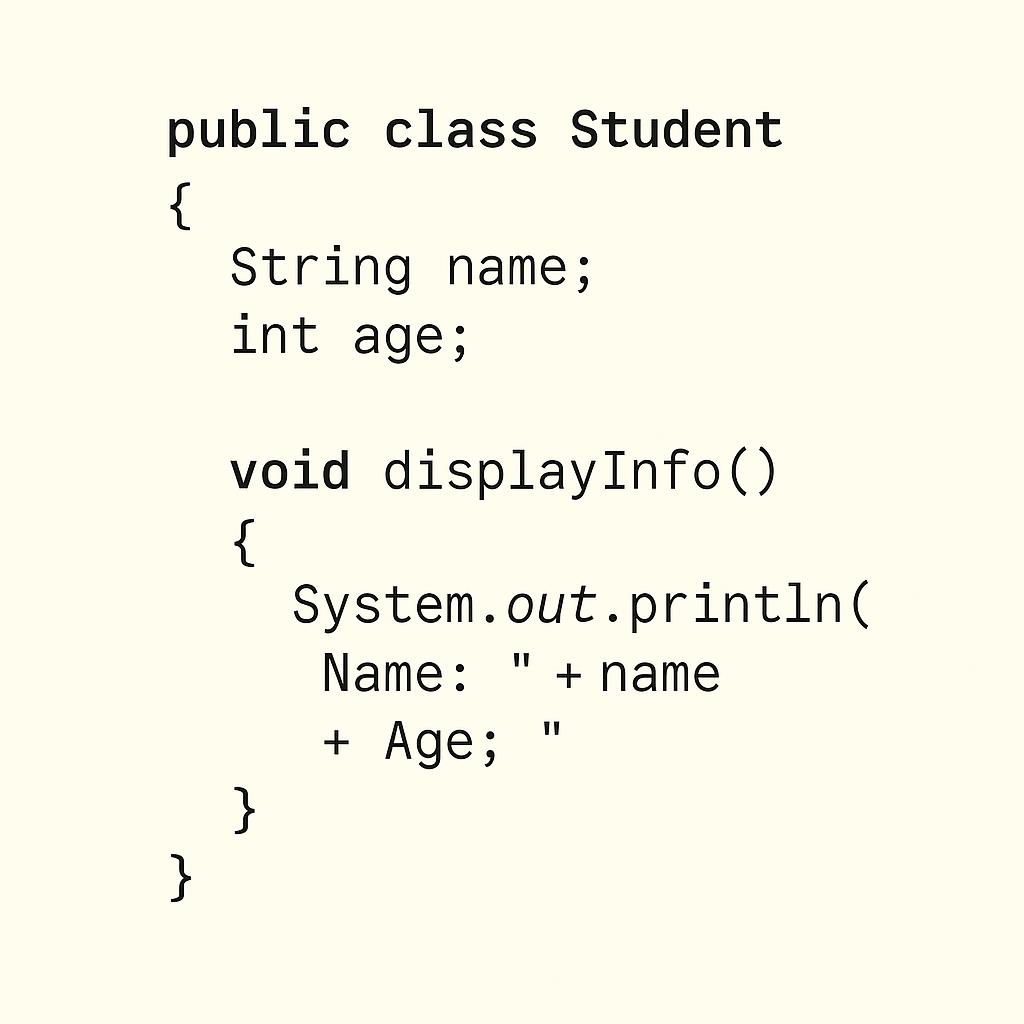Classes and Objects in Java
diagram Java code snippet defining a Student class with name and age
Understanding Classes and Objects in Java: A Complete Guide for Beginners
Introduction
Java is an object-oriented programming language, which means everything in Java is built around classes and objects. If you're new to Java or brushing up your skills, understanding how classes and objects work is crucial to writing clean, efficient, and maintainable code.
In this article, we’ll break down the concept of classes and objects in Java with simple explanations, examples, and use cases. Whether you're preparing for a Java interview or learning Java from scratch, this guide will give you a solid foundation.

What is a Class in Java?
A class in Java is a blueprint or template that defines the structure and behavior of objects.
Key features of a class:
It defines fields (variables) and methods (functions).
It does not consume memory until an object is created.
It can contain constructors, blocks, and inner classes.
Syntax of a Java Class:
public class Car {
String color;
int speed;
void start() {
System.out.println("Car is starting...");
}
}
What is an Object in Java?
An object is an instance of a class. When you create an object, you allocate memory and access class behavior.
Features of an object:
It has a state (defined by fields).
It can perform actions (defined by methods).
You can create multiple objects from one class.
Creating an Object in Java:
Car myCar = new Car(); // myCar is an object
myCar.color = "Red";
myCar.start(); // Outputs: Car is starting...
Real-World Analogy
Imagine a class as a blueprint of a house. You can use this blueprint to build many houses (objects). Each house has its own color, size, and features, but they all come from the same blueprint.
Types of Class Members
| Member Type | Description |
|---|---|
| Fields | Variables inside a class |
| Methods | Functions defined in the class |
| Constructors | Special methods to initialize objects |
| Blocks | Code blocks for static or instance initialization |
| Nested Classes | Classes inside another class |
Constructor in Java
A constructor is used to initialize objects.
Example:
public class Car {
String model;
Car(String m) {
model = m;
}
}
Car myCar = new Car("Honda"); // Constructor called
Practical Example – Java Class and Object
public class Student {
String name;
int age;
void displayInfo() {
System.out.println("Name: " + name + ", Age: " + age);
}
public static void main(String[] args) {
Student s1 = new Student();
s1.name = "Amit";
s1.age = 20;
s1.displayInfo(); // Output: Name: Amit, Age: 20
}
}
Advantages of Using Classes and Objects in Java
Code reusability
Easy to maintain and debug
Enables abstraction, encapsulation, inheritance, and polymorphism
Promotes modular structure in applications
Frequently Asked Questions (FAQs)
Q1: What is the difference between class and object in Java?
A class is a blueprint, while an object is an instance of that blueprint.
Q2: Can we create objects without classes in Java?
No, all objects must be instances of a class.
Q3: Is it necessary to use new keyword to create objects?
In most cases, yes. However, some classes use methods like valueOf() to return objects (e.g., String, Integer).
🏋️️ Conclusion
Understanding classes and objects in Java is the first step in mastering Object-Oriented Programming (OOP). These core concepts help you build scalable, maintainable, and reusable Java applications. Start by practicing simple class-object structures and gradually explore inheritance, polymorphism, and abstraction.
📚 Learn More
✍️ Author: Shubham Mishra
🔗 Website: www.developerindian.com.
🗓️ Published On: July 2025
Table of content
- Introduction to Java
- Java Basics
- Object-Oriented Programming (OOP) in Java
- Exception Handling in Java
- Types of Exceptions
- Try-Catch Block
- Finally Block and Throw/Throws
- Custom Exceptions
- Java Collections Framework
- Introduction to Collections
- List, Set, and Map Interfaces
- ArrayList vs LinkedList
- HashMap vs HashSet
- File Handling in Java
- Multithreading in Java
- Introduction to Threads
- Thread Lifecycle
- Creating Threads (Thread Class vs Runnable Interface)
- Synchronization and Deadlocks
- Networking in Java
- Java Networking Basics
- Socket Programming
- HTTP Requests in Java
- Java Database Connectivity (JDBC)
- Introduction to JDBC
- Connecting to MySQL Database
- Executing SQL Queries
- Using Prepared Statements
- Java Frameworks and Technologies
- Introduction to Spring Framework
- Hibernate ORM
- JavaFX for GUI Applications
- Java Interview Preparation
- Additional Java Resources
- Best Books to Learn Java
- Java Certification Guide
- Online Java Practice Platforms